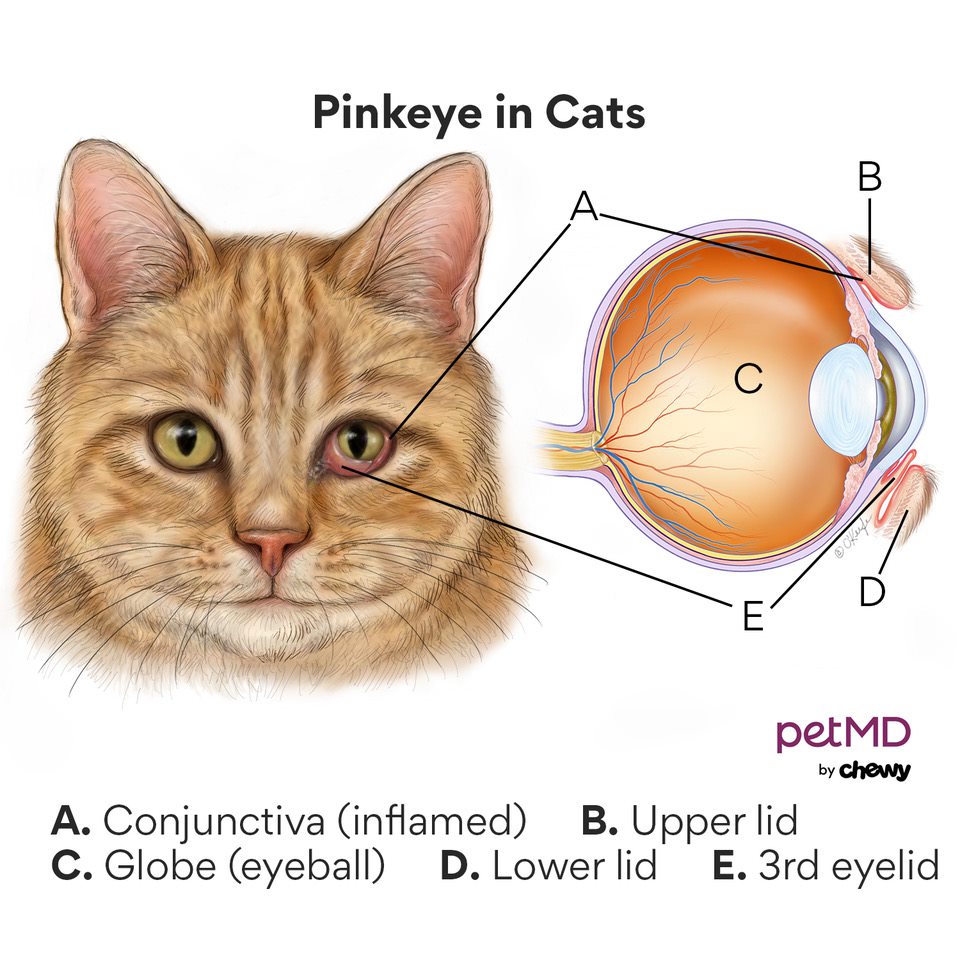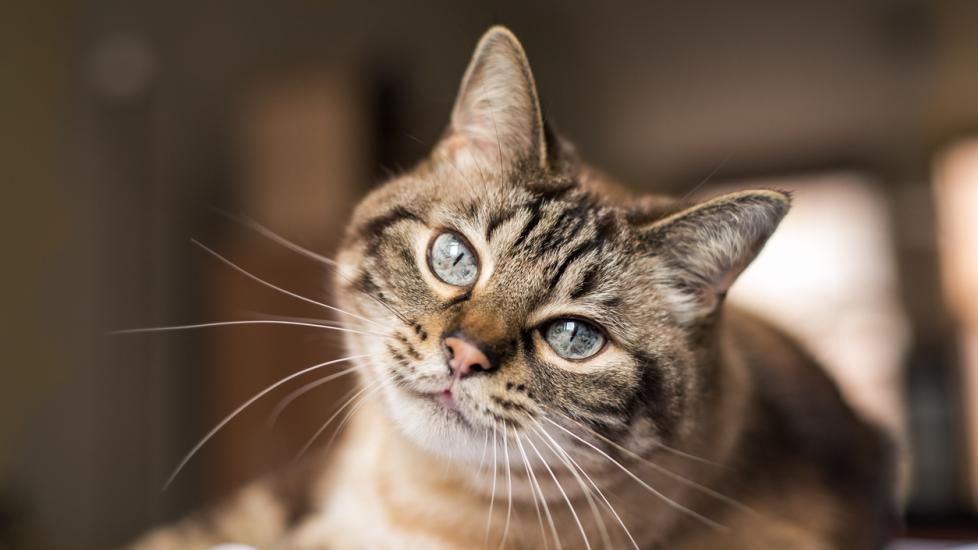Conjunctivitis in Cats (Cat Pink Eye)
What Is Conjunctivitis in Cats?
Conjunctivitis is inflammation of the eye’s conjunctiva. The conjunctiva is the mucous membrane that lines a cat’s upper and lower eyelids, their third eyelid, and the globe of their eye (the eyeball).
Conjunctivitis in cats often occurs acutely (as a short-term condition) and is considered painful. It is one of the most common eye diseases affecting cats.

Symptoms of Conjunctivitis in Cats
Signs of conjunctivitis in cats can range from mild redness around the eyes to much more severe disease:
-
The conjunctival tissues can be inflamed and swollen, causing excessive blinking, squinting, and the inability to fully open and close the eye.
-
There may be clear discharge, mucous, or bloody material coming from the eye.
-
The eyes and the skin around them may be itchy or losing hair.
In addition to seeing symptoms in your cat’s eyes, it’s also common to see signs of an upper respiratory infection. These include:
-
Sneezing
-
Nasal discharge (clear or thick mucus)
-
Decreased appetite
-
Less energy
Causes of Conjunctivitis in Cats
There are many possible causes of conjunctivitis. To determine a formal diagnosis, veterinarians must first break cases down into infectious or noninfectious.
Infectious causes include:
Viral Conjunctivitis—Most cases of conjunctivitis in cats are viral.
- Feline herpesvirus-1 (FHV-1) is the most common cause of conjunctivitis, especially chronic or recurrent cases. The virus hides in the nervous system and activates at times of stress or illness. It’s similar to the human herpesvirus-1, but this family of viruses is species-specific, so FHV-1 cannot infect humans. It is, however, highly contagious to other cats in close contact.
- Calicivirus is another common virus. It’s primarily shed in nose, eye, and mouth secretions, though it can be found in other body fluids. It is also spread via close contact. While many cats recover, others will become lifelong carriers.
Bacterial Conjunctivitis—Frequently, cats with viral conjunctivitis will experience a secondary bacterial infection. But bacteria can be the primary pathogen as well, although bacterial conjunctivitis is less frequent than viral. The most common pathogens are:
- Chlamydophila felis
- Mycoplasma
- Staphylococcus
- Streptococcus
- Bartonella
- Pseudomonas species
Note that C. felis can cross species, although this is not common, humans (particularly those with compromised immune systems) can catch it from infected cats.
Parasitic Conjunctivitis—Outdoor cats are more prone to parasitic infections, which usually cause more systemic disease but can also cause conjunctivitis. These include:
- Leishmaniasis
- Thelaziasis
- Onchocerciasis
Humans may be susceptible to all three of these, but direct transmission is rare. It is important to be aware of any possible cross-species potential and talk to human-health professionals about any concerns.
Noninfectious causes of conjunctivitis include:
Immune-mediated—This uncommon cause of conjunctivitis involves a cat’s immune system attacking itself.
- Eosinophilic conjunctivitis is idiopathic in origin, meaning veterinarians don’t know why it occurs. However, it may have a link to FHV-1. It causes an infiltration of a certain type of white blood cell to the conjunctiva, causing the inflammation.
- Lipogranulomatous conjunctivitis occurs when lipids (fats) are deposited along the eyelid margin, glands, and ducts. Veterinarians are uncertain of the cause of this disease.
-
Allergies are a cause of conjunctivitis for many cats. They can come from the environment (dust, pollen, weeds, mites, fleas, etc.) or in food.
-
Physical irritants can range from foreign bodies like grass, sticks, or eyelashes, to harder-to-diagnose irritants like dust, chemicals, smoke, and eye ointments.
-
Ocular diseases—such as ulcers, glaucoma, eye tumors, or eyelid malformations—can cause secondary conjunctivitis.
-
Eyelid diseases—such as abnormal eyelid anatomy or cancer—involve frictional irritation or exposure and may cause conjunctivitis.
How Veterinarians Diagnose Cat Pink Eye
Your veterinarian will conduct a complete ophthalmic examination, including:
-
A careful eye exam using special instruments and stains to look for other diseases in the eye.
-
A Schirmer Tear Test is used to assess your cat’s natural tear production by determining the amount of tears produced.
-
A fluorescein stain test, which is critical to diagnose corneal ulcers. The cornea is the clear dome-like exterior of the eye. With eye and eyelid issues, cats commonly have ulcers or scratches on the cornea. The fluorescein stain allows an ulcer to glow bright green under a black light.
-
A test of intraocular pressures to look for inflammation or glaucoma.
-
Blood tests specifically looking for two viruses: feline leukemia virus and feline immunodeficiency virus. Cats with either virus are immunocompromised and therefore more susceptible to infections.
-
Blood tests to look for signs of infection and overall organ function.
-
Radiographs to assess lung pathology, as cats with conjunctivitis frequently have respiratory infections.
-
Additional tests may include PCR, virus isolation, immunofluorescence antibody testing, and serology to test for other specific bacterial and viral infections.
Treatment for Conjunctivitis in Cats
The goal of treatment for cat pink eye is eliminating the pain and the infection, as well as treating the underlying cause, if there is one.
Topical eye drops or ointment may be prescribed, along with topical medications for inflammation and pain.
When needed, immune-suppressive drugs are prescribed for immune-mediated cases.
Your veterinarian will go over the proper application of all eye medications, as great care is necessary to avoid further damage to your cat’s eye.
Any other infections will be addressed on a case-by-case basis.
Recovery and Management of Cat Pink Eye
Most cases of simple conjunctivitis in cats resolve relatively smoothly with seven to 10 days of topical therapy.
Longer treatment is warranted for certain infectious agents, and for immune-mediated cases. When complications arise, such as corneal ulceration or sequestration, outpatient surgery may be necessary.
A common cause of conjunctivitis in cats from both rescue and breeder backgrounds is herpesvirus. Herpes infections are sporadic and often first show up during kittenhood.
Many cats are infected with FHV-1 and do not show any signs of clinical illness. In most cases, herpesvirus conjunctivitis is self-limiting and will resolve within two weeks, though the conjunctivitis should still be treated.
With cases of herpesvirus conjunctivitis, the signs often appear suddenly and are especially common after stressful situations such as travel, boarding, surgery, or illness.
When cats do have a flare-up, they are more susceptible to secondary bacterial infections, which can be concerning for young kittens.
Prevention of Conjunctivitis in Cats
Introducing probiotics and maintaining a stress-free environment for your cat can help to prevent viral conjunctivitis flare-ups in cats. Some products your vet may recommend include:
- Fortiflora™ is a probiotic product made by Purina, can decrease the severity of herpes conjunctivitis by utilizing “good” bacteria in the body.
- Lysine is an amino acid that supports the immune and respiratory system in cats.
- Hyaluronate-containing tear ointments or supplements can provide lubrication and support overall proper health of the eye’s tear and glands. Healthy tear films will better clear and manage infections—and the inflammatory issues associated with them.
Good environmental hygiene, a low number of cats in the home, decreased stress, and early veterinary intervention are also helpful in preventing conjunctivitis in cats.
- For multi-cat households, Feliway™ is an effective tool that utilizes pheromones to decrease stress, and therefore decrease the chances of the reappearance of viral conjunctivitis.
- A Thundershirt™ can help cats with anxiety by using calming, gentle pressure, similar to swaddling a baby.
- Prozac and similar prescription medications may be helpful for cats who suffer from more severe anxiety.
While there is no cure for most causes of conjunctivitis in cats, there are many treatments and solutions to effectively manage the condition and allow cats to live their best life.
Conjunctivitis in Cats (Cat Pink Eye) FAQs
Will conjunctivitis in cats go away by itself?
No. True conjunctivitis has an underlying cause that must be treated.
Can conjunctivitis in cats cause blindness?
Yes. If left untreated, conjunctivitis in cats can progress and lead to necrosis of the cornea and blindness.
Is conjunctivitis painful for cats?
Absolutely! This condition is quite painful, which is why you may notice your cat squinting.
How can I treat my cat’s conjunctivitis at home?
You cannot—and should not—attempt to treat this condition with anything other than what your veterinarian has prescribed.
How long does it take for conjunctivitis to clear up in cats?
Many simple cases of conjunctivitis resolve in seven to 14 days with veterinary-prescribed treatment, but chronic cases require prolonged treatment (weeks to months). Cat pink eye will not clear up on its own.
Is conjunctivitis in cats contagious?
The most common causes of conjunctivitis in cats are highly contagious to other cats. However, viruses such as FHV-1 and calicivirus are not contagious to humans and other animals.
Featured Image: iStock.com/Adri
